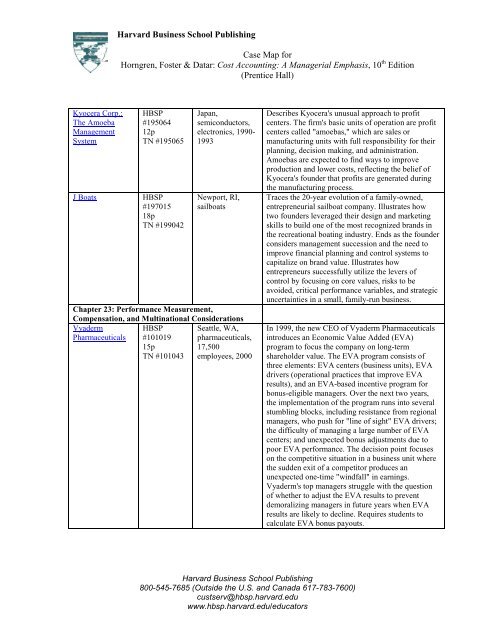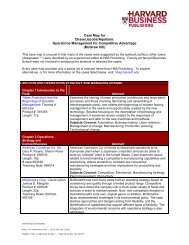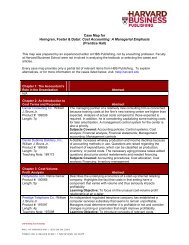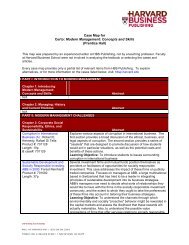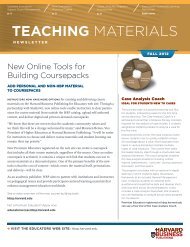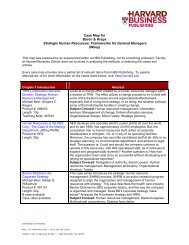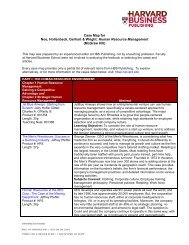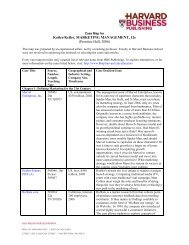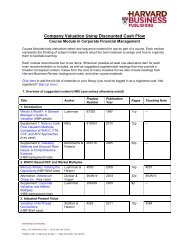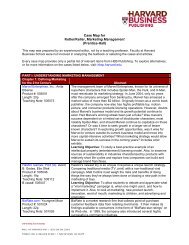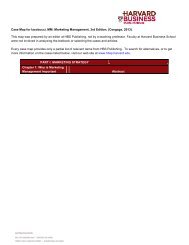Request for Information - Harvard Business School Press
Request for Information - Harvard Business School Press
Request for Information - Harvard Business School Press
Create successful ePaper yourself
Turn your PDF publications into a flip-book with our unique Google optimized e-Paper software.
Kyocera Corp.:<br />
The Amoeba<br />
Management<br />
System<br />
<strong>Harvard</strong> <strong>Business</strong> <strong>School</strong> Publishing<br />
Case Map <strong>for</strong><br />
Horngren, Foster & Datar: Cost Accounting: A Managerial Emphasis, 10 th Edition<br />
(Prentice Hall)<br />
HBSP<br />
#195064<br />
12p<br />
TN #195065<br />
J Boats HBSP<br />
#197015<br />
18p<br />
TN #199042<br />
Japan,<br />
semiconductors,<br />
electronics, 1990-<br />
1993<br />
Newport, RI,<br />
sailboats<br />
Chapter 23: Per<strong>for</strong>mance Measurement,<br />
Compensation, and Multinational Considerations<br />
Vyaderm HBSP Seattle, WA,<br />
Pharmaceuticals #101019 pharmaceuticals,<br />
15p<br />
17,500<br />
TN #101043 employees, 2000<br />
Describes Kyocera's unusual approach to profit<br />
centers. The firm's basic units of operation are profit<br />
centers called "amoebas," which are sales or<br />
manufacturing units with full responsibility <strong>for</strong> their<br />
planning, decision making, and administration.<br />
Amoebas are expected to find ways to improve<br />
production and lower costs, reflecting the belief of<br />
Kyocera's founder that profits are generated during<br />
the manufacturing process.<br />
Traces the 20-year evolution of a family-owned,<br />
entrepreneurial sailboat company. Illustrates how<br />
two founders leveraged their design and marketing<br />
skills to build one of the most recognized brands in<br />
the recreational boating industry. Ends as the founder<br />
considers management succession and the need to<br />
improve financial planning and control systems to<br />
capitalize on brand value. Illustrates how<br />
entrepreneurs successfully utilize the levers of<br />
control by focusing on core values, risks to be<br />
avoided, critical per<strong>for</strong>mance variables, and strategic<br />
uncertainties in a small, family-run business.<br />
In 1999, the new CEO of Vyaderm Pharmaceuticals<br />
introduces an Economic Value Added (EVA)<br />
program to focus the company on long-term<br />
shareholder value. The EVA program consists of<br />
three elements: EVA centers (business units), EVA<br />
drivers (operational practices that improve EVA<br />
results), and an EVA-based incentive program <strong>for</strong><br />
bonus-eligible managers. Over the next two years,<br />
the implementation of the program runs into several<br />
stumbling blocks, including resistance from regional<br />
managers, who push <strong>for</strong> "line of sight" EVA drivers;<br />
the difficulty of managing a large number of EVA<br />
centers; and unexpected bonus adjustments due to<br />
poor EVA per<strong>for</strong>mance. The decision point focuses<br />
on the competitive situation in a business unit where<br />
the sudden exit of a competitor produces an<br />
unexpected one-time "windfall" in earnings.<br />
Vyaderm's top managers struggle with the question<br />
of whether to adjust the EVA results to prevent<br />
demoralizing managers in future years when EVA<br />
results are likely to decline. Requires students to<br />
calculate EVA bonus payouts.<br />
<strong>Harvard</strong> <strong>Business</strong> <strong>School</strong> Publishing<br />
800-545-7685 (Outside the U.S. and Canada 617-783-7600)<br />
custserv@hbsp.harvard.edu<br />
www.hbsp.harvard.edu/educators


